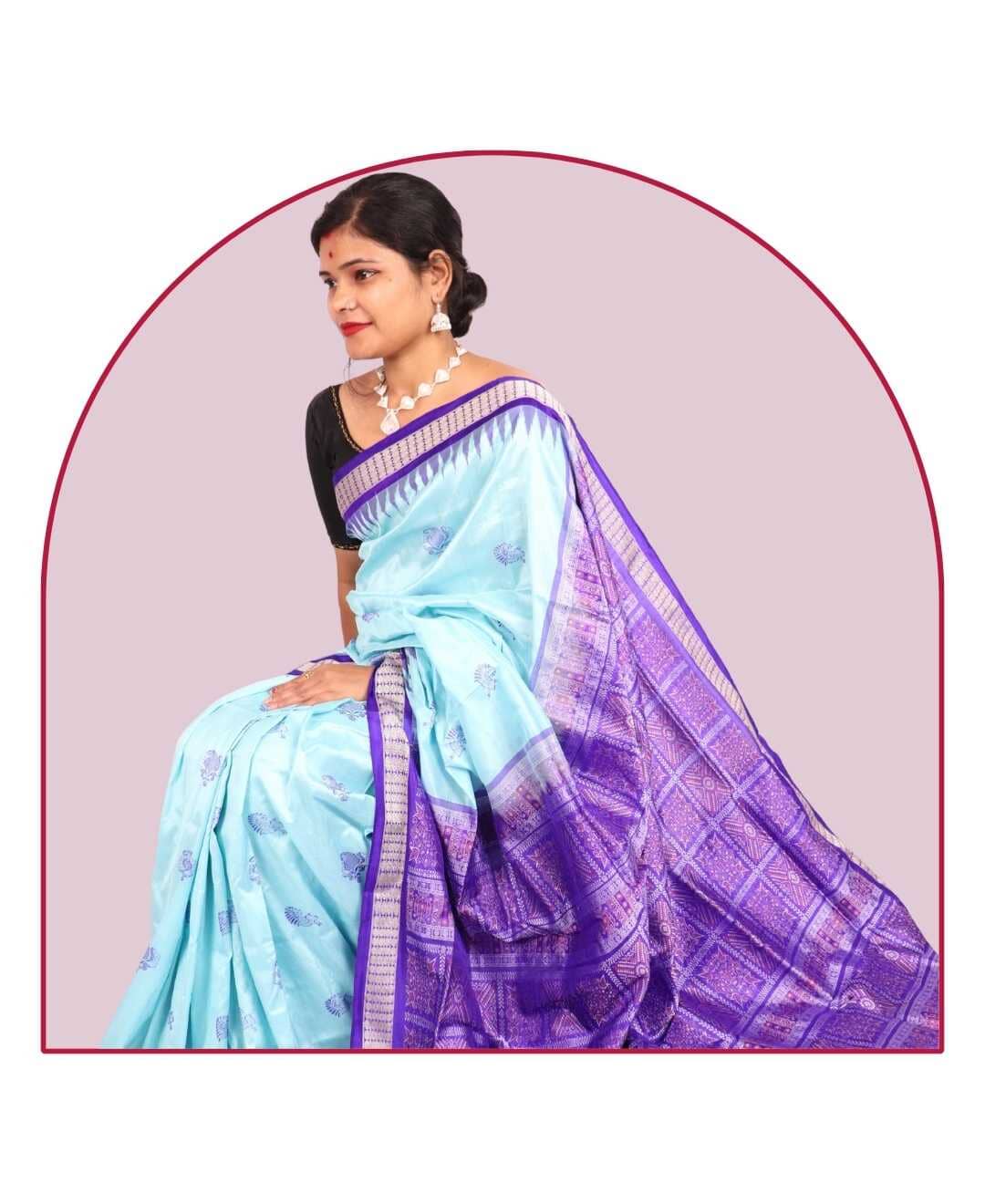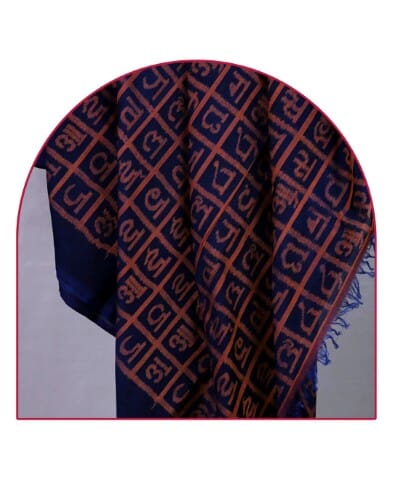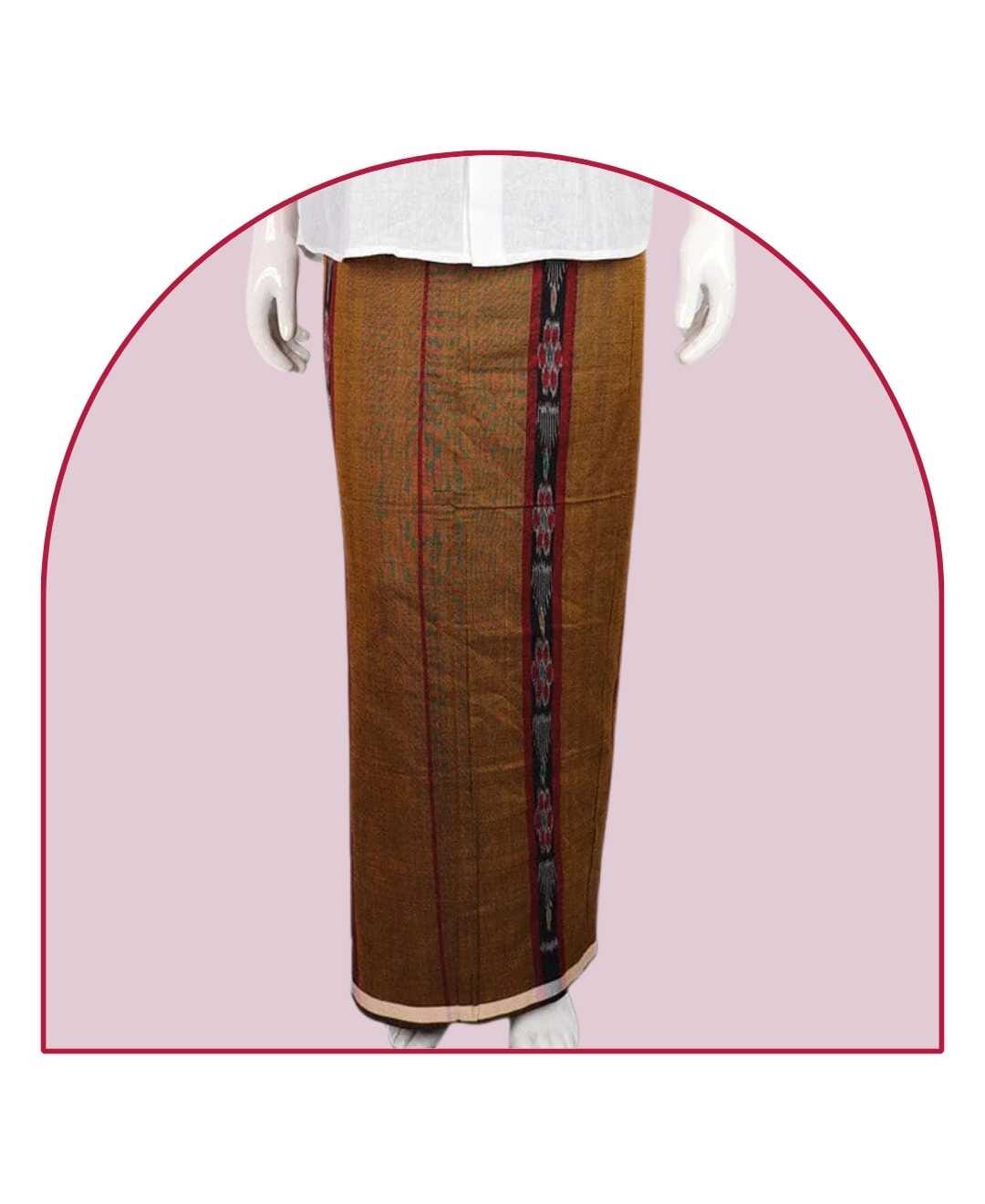ବମ୍କାଇ ଆବିଷ୍କାର କରନ୍ତୁ: ଓଡିଶାର ସମୟହୀନ ରେଶମ ସାରିର ଏଲିଗାନ୍ସ |
ପରିଚୟ
ସମୃଦ୍ଧ ବୁଣା ହୋଇଥିବା ରେଶମ ଶା are ୀ ହେଉଛି ଭାରତର ସାଂସ୍କୃତିକ କପଡ଼ାର ଏକ ଅବିଚ୍ଛେଦ୍ୟ ଅଙ୍ଗ, ଯାହା ସାରା ଦେଶରେ ମହିଳାମାନଙ୍କ ଦ୍ୱାରା ଚମତ୍କାରତା ଦ୍ୱାରା ଚିତ୍ରିତ | ପ୍ରତ୍ୟେକ ଅଞ୍ଚଳ ନିଜର ଅନନ୍ୟ ରେଶମ ବୁଣା ପରମ୍ପରାକୁ ନେଇ ଗର୍ବ କରେ - ମହାରାଷ୍ଟ୍ରର ପାଏଥାନି, ତାମିଲନାଡୁର କଞ୍ଜୀବରାମ, ଉତ୍ତରପ୍ରଦେଶର ବନାରସୀ - ଏହି ତାଲିକା ଅସୀମ | ଏହିପରି ଏକ ସ୍ଥାୟୀ ରତ୍ନ ହେଉଛି ଓଡିଶାର ବୋମକାଇ କିମ୍ବା ସୋନେପୁରୀ ରେଶମ ଶାରୀରୀ | ଏହାର ଚମତ୍କାର ପାଲୁ, ସ୍ପନ୍ଦିତ ରଙ୍ଗ ଏବଂ ପାରମ୍ପାରିକ ହାତରେ ବୁଣାଯାଇଥିବା ଡିଜାଇନ୍ ସହିତ ବମ୍କାଇ ସାରୀ ଏକ କାଳଜୟୀ କ୍ଲାସିକ୍ | ଆସନ୍ତୁ ଏହି ଓଡିର ଉତ୍ପତ୍ତି ଏବଂ ସାଂସ୍କୃତିକ ମହତ୍ତ୍ behind ର ପଛରେ ଥିବା ଆକର୍ଷଣୀୟ କାହାଣୀକୁ ଓଡିଶାର ନ est ତିକ heritage ତିହ୍ୟକୁ ଚିହ୍ନିବା |
ବମ୍କାଇ ସିଲ୍କର ଉତ୍ପତ୍ତି |
ଓଡ଼ିଶାର ଲୁମ୍ସରୁ |
ବମ୍କାଇ ଶାରୀରୀ ସେମାନଙ୍କର ମୂଳ ଓଡ଼ିଶାର ଗଞ୍ଜାମ ଜିଲ୍ଲାର ବମ୍କାଇ ଗାଁକୁ ଖୋଜିଥାଏ। 'ବମ୍କାଇ' ଶବ୍ଦଟି ସଂସ୍କୃତ ଶବ୍ଦରୁ 'ବମ୍' ଅର୍ଥାତ୍ ଲୁମ୍ ଏବଂ 'କାଇ' ଅର୍ଥାତ୍ ହାତରୁ ଉତ୍ପନ୍ନ | ଏହାର ନାମ ଅନୁଯାୟୀ, ଏହି ଶା are ୀଗୁଡ଼ିକ ପାରମ୍ପାରିକ ଲୁମ୍ ଉପରେ ହସ୍ତତନ୍ତ ଭାବରେ ବୁଣା ହୋଇଛି | ବମ୍କାଇ ଏବଂ ବାରପାଲି , ବାପାଟଲା , ଏବଂ ସୋନେପୁର ପରି ନିକଟବର୍ତ୍ତୀ ଗ୍ରାମଗୁଡିକ ବମ୍କାଇ ବୁଣାକାର ପରମ୍ପରାର ଦୀର୍ଘକାଳୀନ କେନ୍ଦ୍ର ହୋଇଆସୁଛି, ଯାହା ମାଷ୍ଟର ବୁଣାକାରଙ୍କ ଦ୍ୱାରା ଶତାବ୍ଦୀ ଧରି ପାଳିତ ହୋଇଥିଲା | Histor ତିହାସିକ ଭାବରେ, ବମ୍କାଇ ଏହାର ଉନ୍ନତ ରେଶମ ନଡ଼ିଆ ଚାଷ ଏବଂ କୁଟୀର ରେଶମ ଶିଳ୍ପ ପାଇଁ ଜଣାଶୁଣା ଥିଲା ଯାହା ରାଜକୀୟ ପୃଷ୍ଠପୋଷକମାନଙ୍କ ପାଇଁ ମଧ୍ୟ ଏହି ସୂକ୍ଷ୍ମ ଶାରୀରୀ ଉତ୍ପାଦନ କରିଥିଲା |
ବମ୍କାଇର ଉତ୍ପତ୍ତି ପଛରେ କିମ୍ବଦନ୍ତୀ |
ଏକ ଆକର୍ଷଣୀୟ ଲୋକନୃତ୍ୟ ମୂଲ୍ୟବାନ ବମ୍କାଇ ସାରୀର ପ th ରାଣିକ ଉତ୍ପତ୍ତିକୁ ଘେରି ରହିଥାଏ | ଲୋକପ୍ରିୟ କିମ୍ବଦନ୍ତୀ ଅନୁଯାୟୀ, ଥରେ ଜଣେ ରାଜା ସ୍ୱପ୍ନରେ ସ୍ୱପ୍ନ ଦେଖିଥିଲେ, ଯେଉଁଥିରେ ସେ ଆଖି ଲଗାଇ ଥିଲେ। ଜାଗ୍ରତ ହେବା ପରେ, ସେ ସ୍ dream ପ୍ନରୁ ତାଙ୍କ ରାଜ୍ୟର ମୂଖ୍ୟ ବୁଣାକାରଙ୍କ ପର୍ଯ୍ୟନ୍ତ ସାର୍ ର s ାଞ୍ଚା ଏବଂ ରଙ୍ଗ ବିଷୟରେ ବିସ୍ତୃତ ଭାବରେ ବର୍ଣ୍ଣନା କରିଥିଲେ | ତା’ପରେ ସେ ବୁଣାକାରମାନଙ୍କୁ ତାଙ୍କ ଦର୍ଶନରୁ ଯାଦୁକରୀ ସାରୀକୁ ପୁନ create ନିର୍ମାଣ କରିବାକୁ ଚେଷ୍ଟା କଲେ | କୁଶଳୀ କାରିଗରମାନେ ରାଜାଙ୍କ କଳ୍ପନାକୁ ନକଲ କରିବା ପାଇଁ ଆବଶ୍ୟକ ଜଟିଳ ବମ୍କାଇ ବୁଣା କ techni ଶଳର ବିକାଶ ପାଇଁ ନିରନ୍ତର କାର୍ଯ୍ୟ କରିଥିଲେ | ଅନେକ କଷ୍ଟଦାୟକ ପ୍ରୟାସ ପରେ, ସେମାନେ ଶେଷରେ ରାଜାଙ୍କ ଦ୍ୱାରା ପରିକଳ୍ପିତ ପ୍ରଥମ ବମ୍କାଇ ଶାରୀରୀ ବୁଣିବାରେ ସଫଳ ହେଲେ | ଲୋକକଥା ଅନୁଯାୟୀ ବମ୍କାଇର ଅନନ୍ୟ ହ୍ୟାଣ୍ଡଲୁମ୍ କ que ଶଳ ଏହିପରି ଭାବରେ ଜନ୍ମ ହେଲା | ରାଜାଙ୍କ ରାଜଧାନୀ ସୋନେପୁର ପରେ ମୂଳ ସୃଷ୍ଟିକୁ 'ସୋନେପୁରୀ ବମ୍କାଇ' କୁହାଯାଉଥିଲା |
ଓଡ଼ିଶାରେ ବମ୍କାଇର ସାଂସ୍କୃତିକ ମହତ୍ତ୍ୱ |
ପାରମ୍ପାରିକ ଓଡିଆ ସମାରୋହରେ ବମ୍କାଇ |
ଓଡିଶାରେ ପରିବାର ଏବଂ ସମ୍ପ୍ରଦାୟର ସଦସ୍ୟଙ୍କୁ ବମ୍କାଇ ସାରି ଉପହାର ନ ଦେଇ କ traditional ଣସି ପାରମ୍ପାରିକ ରୀତିନୀତି କିମ୍ବା ଉତ୍ସବ ସମ୍ପୂର୍ଣ୍ଣ ନୁହେଁ। ବମ୍କାଇର ଜଟିଳ ମୂର୍ତି ଏବଂ ମୋଟିଫ୍ ଅନେକ ସମୟରେ ମନ୍ଦିର କାନ୍ଥକୁ ଶୋଭା ଦେଇଥାଏ, ଏହାର ସାଂସ୍କୃତିକ ଗୁରୁତ୍ୱକୁ ଦର୍ଶାଏ | ଶୁଭ ଲାଲ , କଳା ଏବଂ ସୁନା ରଙ୍ଗର ଉଜ୍ଜ୍ୱଳ ବମ୍କାଇ ସାର୍ ପ୍ରତ୍ୟେକ ଓଡିଆ ହିନ୍ଦୁ ବରର ଟ୍ରାଉଜୋର ଏକ ପାରମ୍ପାରିକ ଅଂଶ | ବିବାହ ସମୟରେ ମାତୃ ମାମୁଁମାନେ ବରଯାତ୍ରୀମାନଙ୍କୁ ରୀତିନୀତି ଅନୁଯାୟୀ ପ୍ରଦାନ କରାଯାଇଥାଏ | ରଜା ପାରବା, ଓଡିଶାର ତିନି ଦିନିଆ ନାରୀ ଉତ୍ସବ ପାଳନ କରୁଥିବାବେଳେ ବମ୍କାଇ ଶାରୀରୀ ଭାଇମାନେ ସେମାନଙ୍କ ବିବାହିତ ଭଉଣୀମାନଙ୍କୁ ଉପସ୍ଥାପନ କରନ୍ତି |
ବାର୍ଷିକ ସୋଲାଖିଆ ଭାରାନି ପର୍ବର ସାକ୍ଷୀମାନେ ଭକ୍ତ ବିଧବାମାନେ ନିଜ ପରିବାରର ମଙ୍ଗଳ ପାଇଁ ପ୍ରାର୍ଥନା କରିବାକୁ ମନ୍ଦିରକୁ ଯିବାବେଳେ ବମ୍କାଇରେ ଡ୍ରପ୍ ହୋଇଥିଲେ। ବମ୍କାଇ ଓଡିଆ ସଂସ୍କୃତିରେ ଅନ୍ତର୍ନିହିତ ଭାବରେ ବୁଣା ଯାଇଥାଏ ଏବଂ ପରିବାର ମଧ୍ୟରେ ଉତ୍ସବ ତଥା ବିଶେଷ ଉତ୍ସବ ପାଇଁ ସେମାନଙ୍କର ପାରମ୍ପାରିକ ଆନୁଷ୍ଠାନିକ ଉପହାର ଭାବରେ |
ସମସାମୟିକ ଓଡିଆ ସଂସ୍କୃତିରେ ବମ୍କାଇର ପ୍ରଭାବ |
ଆଜି ବି, ବମ୍କାଇ ଓଡିଆ ସାଂସ୍କୃତିକ ପରିଚୟରେ ଗଭୀର ଭାବରେ ଜଡିତ | ବିଶିଷ୍ଟ ଜନପ୍ରତିନିଧି ଠାରୁ ଆରମ୍ଭ କରି ସେଲିବ୍ରିଟିଙ୍କ ପର୍ଯ୍ୟନ୍ତ, ବମ୍କାଇ ସାରି ଆନୁଷ୍ଠାନିକ ଉତ୍ସବରେ ଗର୍ବର ସହିତ ପିନ୍ଧାଯାଏ | ଜାତୀୟ ସ୍ତରରେ ଓଡିଶାର ପ୍ରତିନିଧିତ୍ୱ କରୁଥିବାବେଳେ ମୁଖ୍ୟମନ୍ତ୍ରୀ ନବୀନ ପଟ୍ଟନାୟକ ଏବଂ ସଂସଦର ସଦସ୍ୟ ଜୟଶ୍ରୀ ପଣ୍ଡାଙ୍କ ପରି ରାଜନେତାମାନେ ବମ୍କାଇ ବୁଣାକାର ଚିତ୍ରିତ ହୋଇଥିବାର ଦେଖାଯାଏ। ବାର୍ଷିକ ବମ୍କାଇ ପାରାମପାରା ପ୍ରଦର୍ଶନୀ ପରି ହସ୍ତଶିଳ୍ପ ପଦକ୍ଷେପ ମାଧ୍ୟମରେ ରାଜ୍ୟ ଏହି ସାର୍କୁ ସକ୍ରିୟ ଭାବରେ ପ୍ରୋତ୍ସାହିତ କରେ | ନିକଟ ଅତୀତରେ, ବମ୍କାଇଙ୍କୁ ଏହାର historical ତିହାସିକ ଉତ୍ତରାଧିକାରୀ ଏବଂ ପ୍ରାମାଣିକତାକୁ ପ୍ରମାଣ କରୁଥିବା ଏକ ଜିଆଇ (ଭ ograph ଗୋଳିକ ସୂଚକାଙ୍କ) ଟ୍ୟାଗ୍ ପ୍ରଦାନ କରାଯାଇ ଏହାର ସମ୍ମାନକୁ ଆହୁରି ବ ating ାଇଲା |
ବମ୍କାଇ କ’ଣ ଛିଡା କରେ?
ଅନନ୍ୟ ବୁଣା କ ech ଶଳ |
ବମ୍କାଇ ଶାରୀରୀ ହେଉଛି ଶତାବ୍ଦୀ ଧରି ଚାଲିଆସୁଥିବା ଅନୁପଯୁକ୍ତ କାରିଗରର ଉତ୍ପାଦ | ଜ organic ବ ରଙ୍ଗ ବ୍ୟବହାର କରି ରେଶମ ସୂତାକୁ ଜୀବନ୍ତ ରଙ୍ଗରେ ରଙ୍ଗ କରିବା ଦ୍ୱାରା ସୃଷ୍ଟି ପ୍ରକ୍ରିୟା ଆରମ୍ଭ ହୁଏ | ବ୍ୟବହୃତ ହ୍ୟାଣ୍ଡଲୁମ୍ରେ ଏକ ସ୍ୱତନ୍ତ୍ର ଜାକ୍କାର୍ଡ ସଂଲଗ୍ନ ଅଛି | ଏହା ବମ୍କାଇଙ୍କ ସ୍ ature ାକ୍ଷର 'ଅତିରିକ୍ତ ବୁଣା' କ techni ଶଳକୁ ସୁଗମ କରିଥାଏ ଯେଉଁଠାରେ ଏକ ଅତିରିକ୍ତ ବୁଣା ସୂତା ସାରୀର ୱର୍ପ ଏବଂ ବୁଣା ବୁଣା ହୋଇଥାଏ | ସପ୍ଲିମେଣ୍ଟାରୀ ୱେଫ୍ ଅନନ୍ୟ ପୃଷ୍ଠ ଗଠନ ଏବଂ ସାରି ଉପରେ ଛିଡା ହେବା ପାଇଁ s ାଞ୍ଚାଗୁଡ଼ିକ ପାଇଁ ତିନି-ଡାଇମେନ୍ସନାଲ୍ ଇଫେକ୍ଟ ସୃଷ୍ଟି କରେ | ଏହି ଟେକ୍ନିକାଲ୍ ଜଟିଳ ପ୍ରକ୍ରିୟା ବମ୍କାଇ ବୁଣା ପାଇଁ ଅତୁଳନୀୟ ଏବଂ ଏହାର ପୁଷ୍ପ ଏବଂ ଜ୍ୟାମିତିକ ମୋଟିଫ୍ ସେମାନଙ୍କର ସ୍ୱତନ୍ତ୍ର ପରିଚୟ ଦେଇଥାଏ |
ବମ୍କାଇର ପାରମ୍ପାରିକ ମୋଟିଫ୍ ଏବଂ ରଙ୍ଗ |
ପାରମ୍ପାରିକ ଭାବରେ ନାଲି, କଳା, ସୋରିଷ ଏବଂ ହାଲୁକା ପେଷ୍ଟେଲ୍ ଛାଇରେ ବୁଣା ହୋଇଥିବା ବମ୍କାଇ ଏକ ସମୃଦ୍ଧ ରଙ୍ଗ ପ୍ୟାଲେଟ୍ ପାଇଁ ଗର୍ବ କରେ | ନାଲି ବିବାହ, ଉର୍ବରତା ଏବଂ ଉତ୍ସବର ରଙ୍ଗକୁ ସୂଚିତ କରୁଥିବାବେଳେ କଳା ମାତା ପୃଥିବୀକୁ ପ୍ରତିପାଦିତ କରେ | ସବୁଜ ପ୍ରକୃତିର ପ୍ରତୀକ ଅଟେ ଏବଂ ସୋରିଷ ରଙ୍ଗ ଅସନ୍ତୋଷକୁ ବୁ .ାଏ | ପାରମ୍ପାରିକ ଉଦ୍ଦେଶ୍ୟରେ ଶଙ୍କରା (ଶଙ୍ଖ ଶେଲ୍), ଚକ୍ର (ଚକ), ମନ୍ଦିର ସ୍ପାୟର୍ସ, ହାତୀ ଦ୍ୱାରା ଲାଗିଥିବା ଜୀବନ ବୃକ୍ଷ ଏବଂ ଜସ୍ମିନ୍, ଲଟା ଏବଂ ପ th ରାଣିକ ଆଗ୍ନୁକୁଞ୍ଜା ଫୁଲ ପରି ବହୁ ପରିମାଣର ପୁଷ୍ପ ଡିଜାଇନ୍ ଅନ୍ତର୍ଭୁକ୍ତ | ପାଲୁ ଏବଂ ସୀମାରେ ବୁଣା ହୋଇଥିବା ଲୋକପ୍ରିୟ କ୍ଲାସିକ୍ ଡିଜାଇନ୍ରେ ଦେବୀ ଲକ୍ଷ୍ମୀଙ୍କ ଦ୍ inspired ାରା ଅନୁପ୍ରାଣିତ ବାପଟା ବମ୍କାଇ ଏବଂ ରାଧା-କୃଷ୍ଣଙ୍କ ରସଲିଲା ଚିତ୍ରିତ ଦୃଶ୍ୟ ଅନ୍ତର୍ଭୁକ୍ତ |
ଜଣେ ଭାରତୀୟ ମହିଳାଙ୍କ ଆଲମାରୀରେ ବମ୍କାଇର ସ୍ଥାନ |
ସମଗ୍ର ଭାରତରେ ବମ୍କାଇର ବୃଦ୍ଧି ପାଉଥିବା ଲୋକପ୍ରିୟତା |
ଏକଦା କେବଳ ଓଡିଶାର ରୟାଲଟି ଏବଂ ଅଭିଜିତଙ୍କ ଦ୍ ron ାରା ପୃଷ୍ଠପୋଷକତାରେ ବମ୍କାଇ ସାରି ବର୍ତ୍ତମାନ ଦେଶବ୍ୟାପୀ ଲୋକପ୍ରିୟତା ହାସଲ କରିଛି। ବଲିଉଡ ଅଭିନେତାଙ୍କ ଠାରୁ ଆରମ୍ଭ କରି ସାବ୍ୟସାଚି ପରି ଭାରତର ଶ୍ରେଷ୍ଠ ଡିଜାଇନର୍ମାନଙ୍କ ପାଇଁ ରନୱେ ଚାଲୁଥିବା ମଡେଲଗୁଡିକ ପର୍ଯ୍ୟନ୍ତ, ବମ୍କାଇର ବିଶୋଧିତ ଶୋଭା ନିଜ ଦେଶ ବାହାରେ ଖ୍ୟାତି ଅର୍ଜନ କରିଛି | ଆଜି, ଆପଣ ସମଗ୍ର ଦେଶରେ ଆଧୁନିକ ଭାରତୀୟ ମହିଳାଙ୍କୁ ପର୍ବପର୍ବାଣୀ, ବିବାହ ଏବଂ ଏପରିକି କର୍ପୋରେଟ୍ ଇଭେଣ୍ଟ ପାଇଁ ଏହି ହସ୍ତତନ୍ତ ଚମତ୍କାର ଚିତ୍ର ଆଙ୍କି ପାରିବେ | ଯୁବ ଡିଜାଇନର୍ମାନେ ବମ୍କାଇକୁ ଏହାର ବୁଣା ଏବଂ ଆଣ୍ଟି-ଫିଟ୍ ଶ yles ଳୀ ସହିତ ପରୀକ୍ଷଣ କରି ଏକ ନୂତନ ରୂପ ଦେଉଛନ୍ତି |
ବମ୍କାଇ ମ୍ୟାଜିକ୍ ଷ୍ଟାଇଲ୍ କରିବା |
ବମ୍କାଇ ସାରୀକୁ ଡ୍ରାପ୍ କରିବାର କ୍ଲାସିକ୍ ଉପାୟ ହେଉଛି ପାରମ୍ପାରିକ ଶ style ଳୀରେ - ଧନୀ s ାଞ୍ଚାଗୁଡ଼ିକୁ ଚିତ୍ରଣ କରିବା ପାଇଁ ଆଗରେ ପିନ୍ଧାଯାଇଥିବା ପାଲୁ ସହିତ ଦୃ ly ଭାବରେ ସନ୍ତୁଷ୍ଟ | ପେଷ୍ଟେଲ ରଙ୍ଗରେ ବିପରୀତ ଓଡନା କିମ୍ବା ଦ୍ୱିତୀୟ ସାରୀର ବ୍ୟବହାର ମଧ୍ୟ ସାଧାରଣ ଅଟେ | ଉଜ୍ଜ୍ୱଳ ରଙ୍ଗକୁ ଅଧିକ ସୁଦୃ To ଼ କରିବା ପାଇଁ, ବମ୍କାଇ ଅଳଙ୍କାର ମନ୍ଦିର ହାର, ang ୁଲୁଥିବା କାନଫୁଲ ଏବଂ କେଶରେ ଗଜ୍ରା ଫୁଲ ବ୍ରେଡ୍ ସହିତ ଯୋଡି ହୋଇଛି | ଏକ ଆଧୁନିକ ମୋଡ଼ ପାଇଁ ବମ୍କାଇ ପ୍ୟାଣ୍ଟ, ସ୍କର୍ଟ ଉପରେ ଅଙ୍କିତ ହୋଇଛି କିମ୍ବା ପ୍ରି-ସିଲେଇ ହୋଇଥିବା ପୋଷାକ, ଫସଲ ଟପ୍ କିମ୍ବା ସାର୍ଟ-ସାରି ଭାବରେ ଷ୍ଟାଇଲ୍ ହୋଇଛି | ବମ୍କାଇଙ୍କ ରାଜକୀୟ ଶୋଭା ମଧ୍ୟ ଏହାକୁ ଆଧୁନିକ ଭାରତୀୟ ବର ଏବଂ ବ୍ରୋକେଡ୍ ଲେହେଙ୍ଗା ପାଇଁ ଉପଯୁକ୍ତ କରିଥାଏ |
ସିଦ୍ଧାନ୍ତ
ବମ୍କାଇ ସାରୀର ସ୍ଥାୟୀ ଯାତ୍ରା , ଓଡିଶାର ସଂସ୍କୃତିର ବୁଣା ଏବଂ ବୁଣା ଦ୍ୱାରା ବୁଣା ଯାଇଛି, ତାହା ପ୍ରକୃତରେ ଆକର୍ଷଣୀୟ | ଏହାର ବୁଣାକାରମାନଙ୍କର ଦକ୍ଷ ହାତ, ଏହାର ଡିଜାଇନ୍ଗୁଡ଼ିକର ସମୃଦ୍ଧତା ଏବଂ ପରମ୍ପରା ସହିତ ଏହାର ପ୍ରତୀକାତ୍ମକ ସମ୍ପର୍କ ପ୍ରତ୍ୟେକ ସୂତ୍ରରେ ଯାଦୁ ସୃଷ୍ଟି କରିବାକୁ ଏକତ୍ରିତ ହୁଏ | ଯେହେତୁ ଭାରତ ଏହାର ଅବିଶ୍ୱାସନୀୟ ହସ୍ତତନ୍ତ heritage ତିହ୍ୟକୁ ଗ୍ରହଣ କରେ, ବମ୍କାଇ କିମ୍ବଦନ୍ତୀରେ ଆହୁରି ଅନେକ ଅଧ୍ୟାୟ ଲେଖାଯାଇପାରେ ଯାହା ଶତାବ୍ଦୀ ଧରି ମହିଳା ପି generations ଼ିଙ୍କୁ ପ୍ରେରଣା ଯୋଗାଇଥାଏ | ଏହାର ଭବିଷ୍ୟତ ଏହାର ସୂତାରେ ରଙ୍ଗ ହୋଇଥିବା ରଙ୍ଗ ଅପେକ୍ଷା ଆହୁରି ଉଜ୍ଜ୍ୱଳ ଦେଖାଯାଏ, ଏହାର ପ ancest ତୃକ ବୁଣା ସମ୍ପ୍ରଦାୟର ଦର୍ଶନ ଯୋଗୁଁ ସମସ୍ତେ ଧନ୍ୟବାଦ |
ସନ୍ଦର୍ଭ
- ଓଡ଼ିଶା ପର୍ଯ୍ୟଟନ | "ବମ୍କାଇ ସାରି" 2022
- ଓଡ଼ିଶାରେ ତିଆରି କରନ୍ତୁ | "ବମ୍କାଇ ସାରୀର ଇତିହାସ ଏବଂ ଜିଆଇ ଟ୍ୟାଗ୍" | 2021
- ବୋଇଗୋଡା, ରୋହନ “ବମ୍କାଇ ସାରିକୁ ଡିକୋଡିଂ” | ସୋନେପୁର ହ୍ୟାଣ୍ଡଲୁମ୍ | 2022
- ମହାନ୍ତି, ପ୍ରତୀକ “ବମ୍କାଇର ରହସ୍ୟ ଉନ୍ମୋଚନ” | ହିନ୍ଦୁ 2018
- ଦାସ, ପ୍ରିୟଦର୍ଶିନୀ | “ଜିଆଇ ଟ୍ୟାଗ୍ - ଓଡିଶାର ବମ୍କାଇ ପାଇଁ ମାର୍କ ଅଫ୍ ଏକ୍ସଲେନ୍ସ” | ଓଡ଼ିଶା ବାଇଟ୍ | 2021
- ବେହେରା, ମିନାକେଟାନ୍ | "ଓଡିଶାର ପାରମ୍ପାରିକ ବମ୍କାଇ ସାରୀ" | ଓଡିଶା ସମୀକ୍ଷା। 2019
- ମିଶ୍ର, ସୁଜିତ କୁମାର। “ବମ୍କାଇର ଗ୍ରାଣ୍ଡେର୍” | ମଧ୍ୟମ 2021

























The price of Bombay sarees are too high. And if small stars, 🌸🌺🌻🌹🌷🌼💐flowers are woven, the sarees will become more attractive. And price is also too high. To get the market, it must be reduced.
ଏକ ମନ୍ତବ୍ୟ ଦିଅନ୍ତୁ |